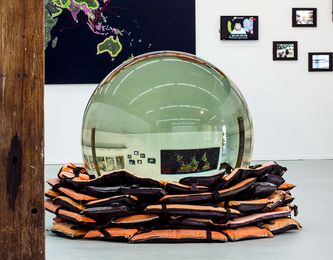Art can be exhausting. It can also be invigorating. Three art festivals within one week can take its toll. But, it did not because I was in the good company of Riyas Komu and other curators. The Australian Arts Council (ACA) had invited us to participate in the visiting international curators programme, along with 11 other curators from different institutions, museums and galleries around the world. It can be exacting. On the contrary, it was exciting. As artist Marco Fusinato’s work at the Sydney biennale demonstrated, minimalism can go with maximalism. His work established the fact that noise can coexist with silence.
The 21st edition of Biennale of Sydney was curated by Tokyo-based Mami Kataoka, chief curator of the Mori Museum. Since 2005, the city has been following a tradition of opening any project or festival with a blessing ceremony presided over by an Aboriginal. This time, the biennale opened with a smoking ceremony, which is a cleansing ritual performed only on special occasions. The guidance of ACA project officers Sabina Finnern and Matthew Loftus helped us understand the journey of the Biennale of Sydney, the Adelaide biennale and the Melbourne design triennial.
The high point of the Sydney biennale this time was a conversation between Kataoka and the legendary Chinese artist Ai Weiwei. Sometimes art events can be tiring for the participants. However, Weiwei’s two works—Crystal Ball (crystal, life jackets) and Law of the Journey (reinforced PVC, with aluminium frame)—made up for it all. When an artist’s work speaks for him, he does not need a pulpit to shout from.
This space is not enough to list all the artists who made a lasting impression on the viewers, but the works of Australian artists Brook Andrews and Khalid Sabsabi did have some incredible resonance.
The Sydney biennale was spread across seven sites: Art Gallery of New South Wales, Museum of Contemporary Art Australia, Artspace, Carriageworks, Cockatoo Island, Sydney Opera House and, for the first time, 4A Centre for Contemporary Asian Art.
Each site offered its own speciality, and Kataoka had put a lot of thought into allocating each of the 69 participating artists their space. Among them were four Indian artists and one of Indian origin: Sosa Joseph, Prabhavati Meppayil, Tanya Goel, N.S. Harsha and Simryn Gill.
It was a moment to cherish, and I was pleasantly surprised when a gallerist and collector from Australia asked me if I knew Sosa Joseph. “Of course,” I replied, because Sosa was part of the first edition of the Kochi-Muziris Biennale. And, it is amazing how things fall into place, and are connected without our knowledge. Kataoka has been a regular visitor to KMB, and it was during one of those visits that Harsha mentioned Sosa’s name to her. She made it a point to visit Sosa’s studio in Kochi. Prabhavati, too, was a participating artist in Kochi.
All these thoughts and cross-connections occupied my mind as we cruised through the packed schedule that included visiting various locations of the biennale, meeting artists, directors and curators, and visiting the respective studios and residencies. There was one thing that stood out through all of that: every organisation had a huge responsibility to perform well. And, every one entrusted with that responsibility was a stakeholder in its successful execution. And, I thought, what if the Australian Council of Arts did not have people like Wendy Were and Amrit Gill? They make an important contribution towards ensuring that art does not become tiring, irrespective of how much you pack into the itinerary.
editor@theweek.in


